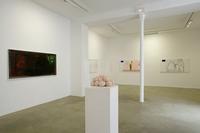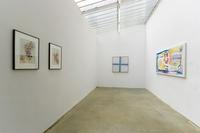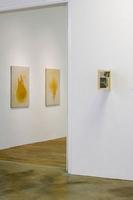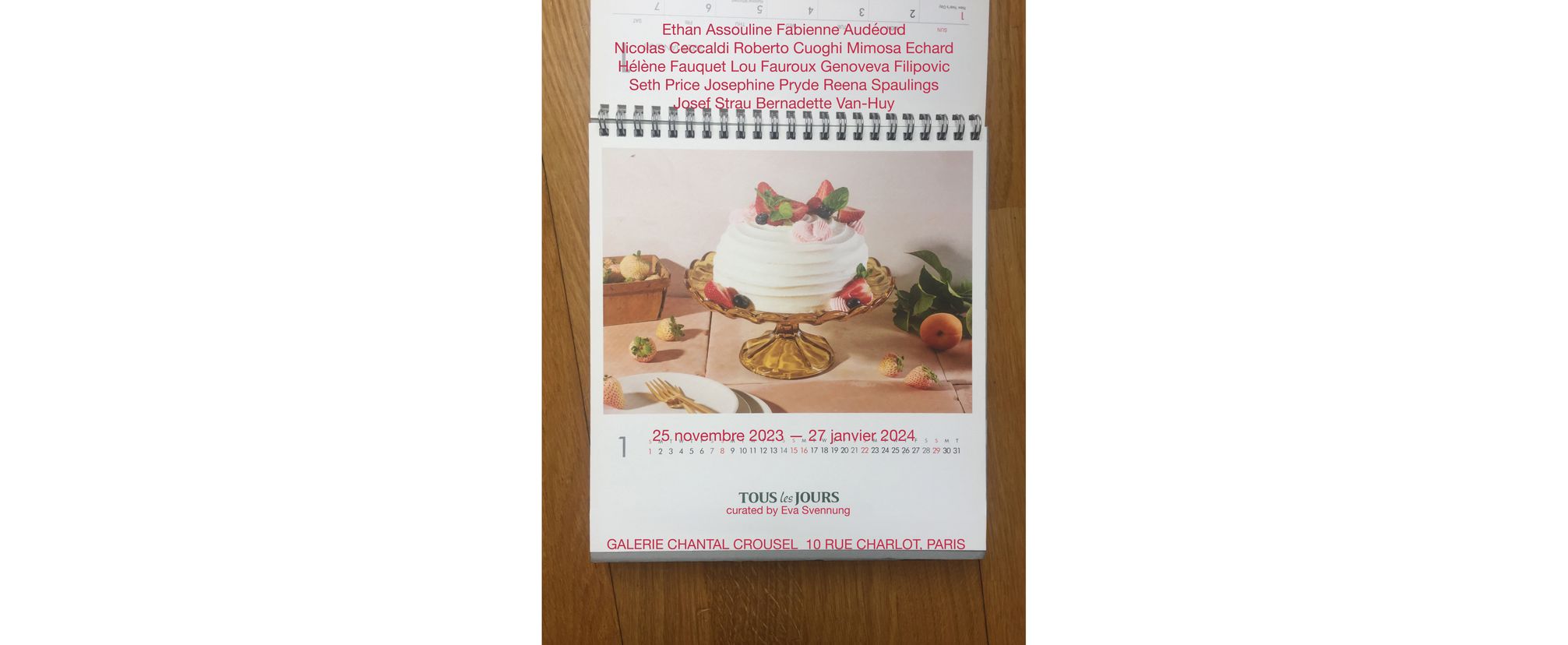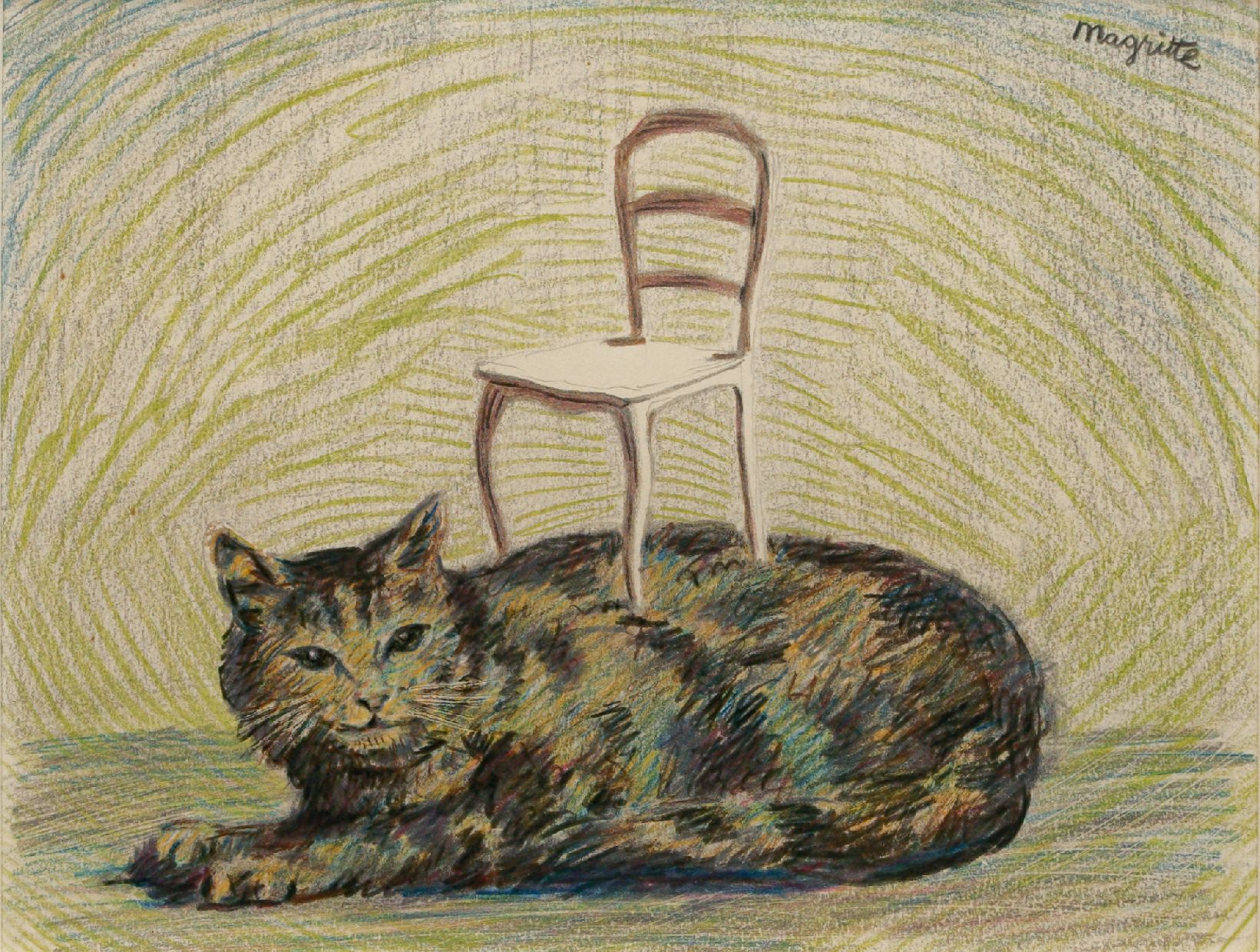MARCEL BROODTHAERS
“Me too, I asked myself if I could not sell something and succeed in life. For some time now, I have been a good-for-nothing. I have forty years of age…”
Invitation card for the exhibition at the Galerie Saint-Laurent, Brussels, April 10-25, 1964 – double page of a magazine, printed on both sides
“And the language of these plaques ? Let’s say a rebus. And the subject: a speculation on a difficulty in reading caused by the use of this material. You should know that one produces these plaques like waffles.” MB
- A,B,C, Embossed and painted plastic plaque, 1969
- Plaster balls, 1964
MICHAEL KREBBER
A leading figure of the Cologne conceptuel scene that has delevoped there since the eighties.
A student of Lüpertz, then an assistant of Baselitz, he soon becomes the long lasting sharer of Kippenberger’s practices. During several years following this period, and for obvious reasons, he takes his distance to painting, before coming back to the foreground with his own works : paintings, collages and altered ready-mades of all sorts.
Untitled, 2000, oil on canvas, is part of the monochrome paintings started in 1990 - in which one finds
references to Kaspar-David Friedrich as well as to Herman Melville and to Paul Valéry, whose « Monsieur Teste » is Krebber’s preferred anti-hero.
ROBERT MALAVAL
«The purpose of painting is not only to ‘express itself’, but to make a concrete object for the others. This is why the decorative aspect does not disturb me at all. Léger, Matisse have been decorative. If a painting is not at all decorative, one does not look at it. » RM
« Glitter is the make-up of painting. (…) I have seen that glitter multiplied, amplified the brush stroke (like the passage of the classic guitar to the rock guitar, with its effects of distortion). Rock is glitter; it is the global articulation that matter : glitter increases intensity. (…) Through glitter, I have rediscovered the pleasure in the gesture of painting, the physical, manual pleasure of moving. » RM
- 2000 Light Years from Home, 1973, acrylic and glitter on canvas
- Arsène Lupin, 1974, acrylic and glitter on paper
SIGMAR POLKE
To close the series of 22 paintings that frame the Bicentennial anniversary of the French Revolution, Sigmar Polke has painted Paper rolls with motifs based on the revolution I, a metaphorical parody on a major episode in modern history. This pop style parody winks at the coloured popular imagery in which Polke has dug out to compose the 21 preceding paintings. As opposed to these, in the last painting of the series his palette is reduced to black, blue, white and red.
The source of this painting is a motif drawn from a Co.ré.di.mag catalogue of shop furnishings, spring-summer 1989.
-Paper Rolls with Motifs Based on the Revolution I, 1989, mixed media on double canvas
JOSEPHINE PRYDE
A British conceptual artist, Josephine Pryde works in the field of photography, drawing, installation and performance. « Her works always describe what can be seen in them; they are both signifier and signified. The artist is responsible for what is depicted and its description, but also for the role models and replicas, the historical material that she allows. (…) Pryde exploits the added value that images can create for her purposes without fully giving away the secret of the project. These pictures describe the distance between focused and blurred, picture and empty space, encoding and reception. » (Matthias Herrmann)
In the present context: money or the absence of money – the fluid, the game, the capitalistic system or its dream.
-Credit cards, 2004, unique c-prints and silver gelatine prints.
REENA SPAULINGS
A New York artist on whom the whole art world (artists, critics, galleries, collectors) has its eyes fixed. Referring to her multiple, often contradictory professional activities, Spaulings quoted the invitation card for Marcel Broodthaers‚ first solo exhibition in Brussels, April 10-25, 1964, where he announces his career shift from poetry to visual art
(see above: Marcel Broodthaers).
The Money Paintings series presented here was originally produced for the Baltic Triennial, Vilnius, autumn 2005. These works (mixed media on canvas) are based on bank notes from the E.U., various countries and former colonies, erasing their concrete values and authenticating marks in order to produce generic, painterly abstractions. They are « aesthetic dollars » whose space, colors and design elements are taken from the governments and monetary institutions that issued them.
ANDY WARHOL
Andy Warhol makes the Piss Paintings (1978) during the same period as the Oxidation Painting.
« Although the Oxidation Paintings (1977-1978) were consciously made to refute (..) negative reputation – when he was told that a New York tastemaker had said that he wasn’t avant-garde anymore, Warhol retorted : « Did you tell her about the Piss Paintings ? » - these were not shown until late in 1986, and thus their impact along with the critical attention and acclaimer they excited was delayed by almost a decade. » (Rosalind Krauss, « The Madness of the Day »)
In his text « A Primer for Urochrome Painting », Benjamin Buchloh states : « Urinating onto the canvas is not only an act of public defilement of a once sacred or virginal space (in that sense it operates like graffiti), it is also an ostentatiously polemical gesture of defiance of the demand for painting as production.
By contrast, painting - as spilling - is waste, and in as much as the process of staining is out of manual control, it defies the economies of order and measure warranted by a well-crafted product. »
Piss Painting, 1978 (1 and 2), urine on gesso on canvas
* Film by Rainer-Werner Fassbinder, 1970
A DETAILED DOCUMENTATION ON EACH ARTIST IS AVAILABLE AT THE GALLERY
